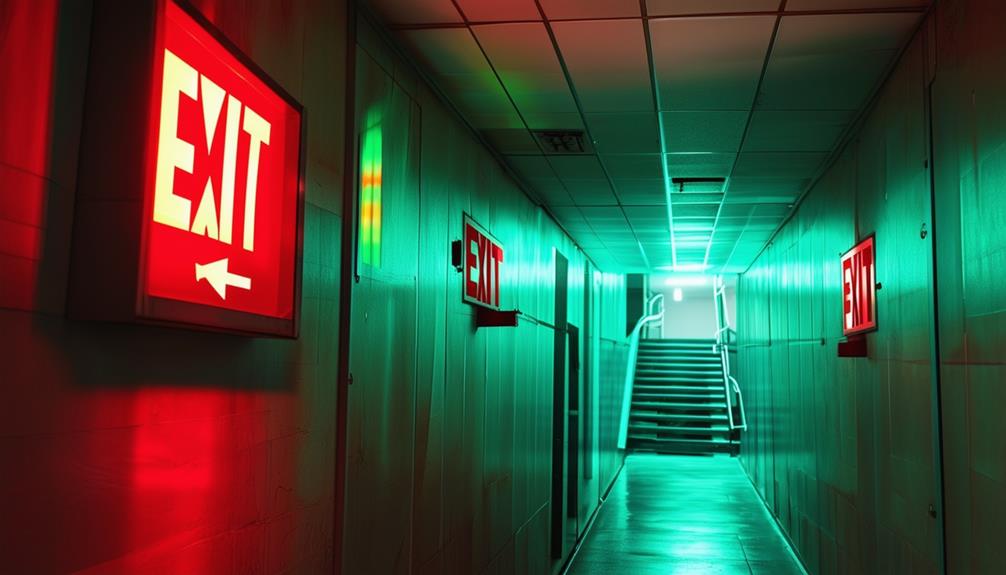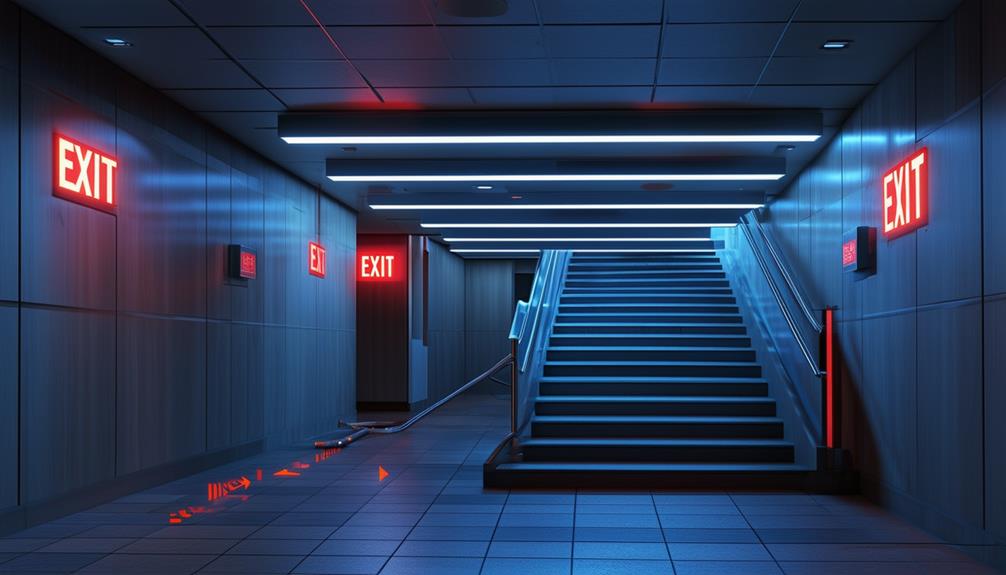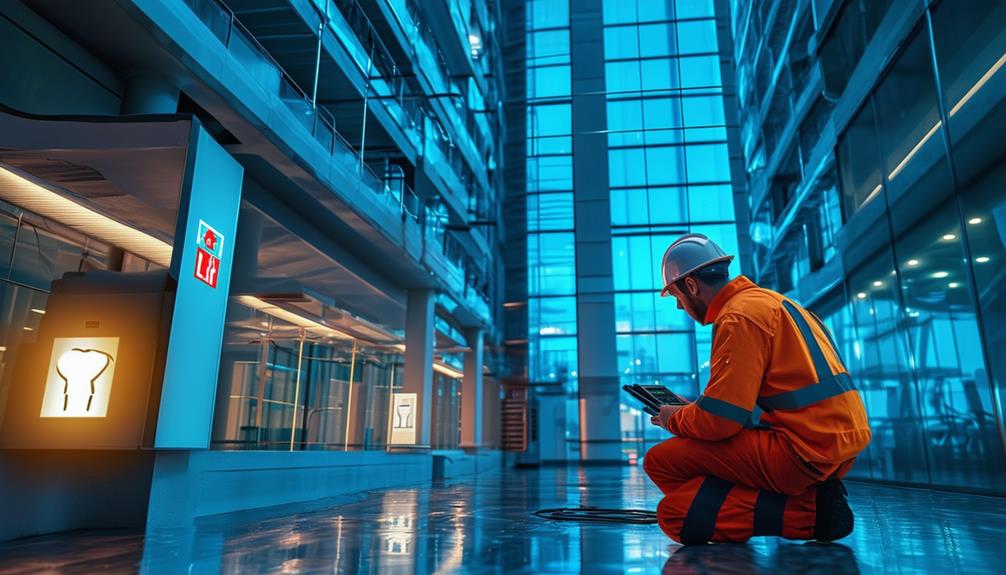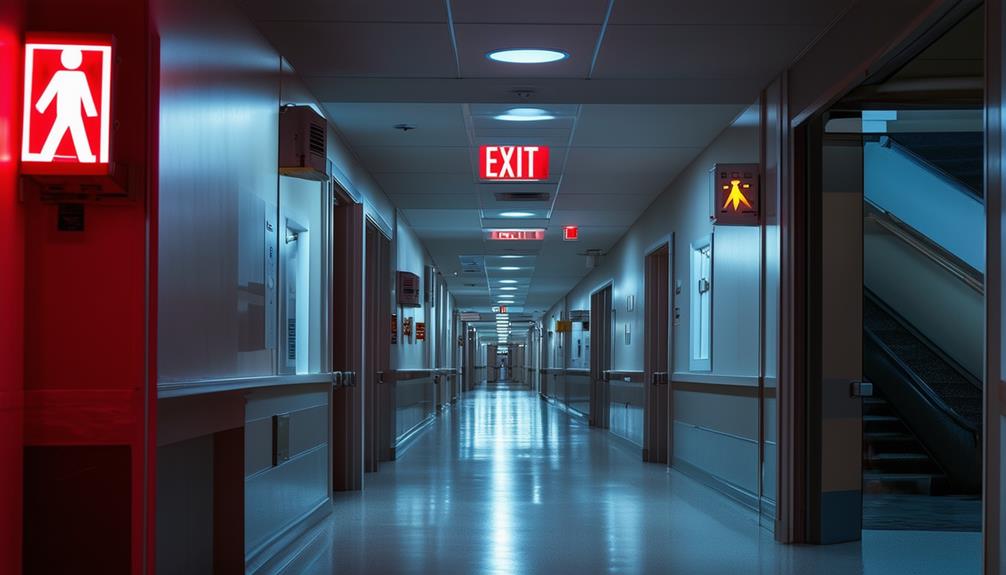The Role of Emergency Lighting in High-Rise Buildings

Imagine you're in a high-rise building during a power outage. Without emergency lighting, navigating dark hallways and stairwells would be chaotic and hazardous.
Emergency lights are not just helpful; they are crucial for guiding occupants safely to exits. But how do these systems work, and what regulations ensure they meet safety standards?
Understanding the components, maintenance, and compliance of emergency lighting systems can significantly enhance safety protocols in tall structures.
So, what elements make these systems reliable when you need them most?
Importance of Emergency Lighting

Emergency lighting is crucial for ensuring safe evacuation in tall buildings during power outages or emergencies. When the power fails, darkness can cause panic, making it difficult to locate exits. Emergency lighting mitigates this risk by illuminating paths to safety, guiding occupants to exits and stairwells.
Exit signs are an integral part of emergency lighting systems. These signs must be illuminated, clearly visible, and unobstructed to ensure they can be easily located during an emergency. Proper placement and maintenance of exit signs significantly enhance safety by marking the safest routes out of the building.
The NFPA 101 standard requires that emergency lighting provide at least 1.5 hours of illumination in tall buildings. This ensures sufficient time for safe evacuation, even during prolonged power outages. Adherence to NFPA 101 isn't merely regulatory compliance; it's essential for the safety of everyone in the building.
Regular maintenance of your emergency lighting system is vital for both safety and compliance. Routine checks ensure that lights and exit signs are operational when most needed.
Key Regulations and Codes
Understanding the key regulations and codes for emergency lighting in high-rise buildings is crucial for compliance and safety. Emergency lighting and clearly visible exit signs must be provided to facilitate safe evacuation during emergencies. NFPA 101, known as the Life Safety Code, mandates standards for emergency lighting to ensure safe egress in high-rise buildings. Compliance with IBC Chapter 10 is also necessary, as it specifies requirements for the duration and intensity of emergency illumination.
Additionally, securing an emergency power source is essential for these systems. NEC Article 700 provides guidelines for the installation and operation of emergency lighting, emphasizing the need for reliable power sources to maintain functionality during outages. Adherence to NFPA 110 and NFPA 111 ensures that emergency lighting systems meet performance standards, providing reliable illumination when needed.
Authorities Having Jurisdiction (AHJ) strictly enforce these regulations to safeguard building occupants' safety.
Emergency Lighting Components

In high-rise buildings, key components of emergency lighting systems include battery-powered units, inverters, and distributed solutions. These elements ensure that your building remains safely navigable during power outages. Battery-powered systems are designed to activate immediately when the main power supply fails, illuminating egress paths to guide occupants to safety. They provide immediate, localized lighting in critical areas.
Inverters centralize control for multiple luminaires, ensuring a larger portion of the building remains illuminated. This centralized approach is efficient for maintaining power to essential lighting during an emergency.
Distributed solutions, often utilizing battery-powered LED drivers, offer flexibility by dispersing emergency lighting throughout the building. This is particularly useful in complex layouts, ensuring comprehensive illumination.
Compliance with NEC Article 700 is mandatory for the proper installation and operation of these systems. This ensures that all emergency lighting components meet stringent safety standards, providing confidence that your high-rise building is prepared for any power loss scenario.
Proper installation and regular maintenance are crucial for the reliable performance of these components when needed most.
Control and Operation
Smart lighting controls and automated power activation are essential for ensuring emergency lighting operates when needed.
Utilizing occupancy sensors and integrating with fire alarm systems can effectively manage these systems.
Adhering to energy codes enhances safety and compliance in high-rise buildings.
Intelligent Lighting Controls
Intelligent lighting controls in tall buildings ensure automated activation of emergency lighting systems during power outages, thereby enhancing safety and reliability. These controls integrate seamlessly with building management systems, providing real-time monitoring and diagnostics of emergency lighting status. This integration allows for prompt resolution of any issues, maintaining the integrity of your emergency lighting systems.
Occupancy sensors are a crucial component of these intelligent systems. They optimize the use of emergency lighting by activating lights only when needed, significantly improving energy efficiency. This is especially beneficial in tall buildings where energy consumption can be substantial.
Additionally, intelligent lighting controls often include fire alarm tie-ins. These tie-ins automatically trigger the emergency lighting system during fire emergencies, ensuring all escape routes are well-lit and easily navigable.
Compliance with energy codes such as IECC 2021 and ANSI/ASHRAE/IES 90.1-2019 is another advantage. These systems are designed to meet strict energy efficiency standards, helping you remain compliant with regulations while maximizing safety and efficiency.
Automated Power Activation
Automated power activation ensures that emergency lighting immediately illuminates during power outages, providing essential safety in high-rise buildings. When the main power fails, these automated systems activate to guarantee that emergency lighting is instantly available, facilitating safe evacuation. This is particularly crucial in high-rise buildings where rapid egress is necessary.
These systems frequently incorporate occupancy sensors and fire alarm integrations to manage lighting efficiently. Occupancy sensors detect movement, ensuring that lights are activated only when needed, thus conserving energy while maintaining safety. Fire alarm integrations ensure that emergency lighting activates simultaneously with fire alarms, providing immediate illumination during critical moments.
Energy codes such as IECC 2021 and ANSI/ASHRAE/IES 90.1-2019 regulate the operation of these systems, ensuring they adhere to strict standards for both efficiency and reliability. These codes mandate that emergency lighting systems aren't only effective but also energy-efficient, enhancing both safety and sustainability.
Testing and Compliance

Regular inspection protocols are essential to ensure your emergency lighting systems comply with performance testing requirements. Adherence to NFPA, IBC, and NEC regulations is crucial, and periodic functional tests are required.
Maintain detailed records of all testing and maintenance activities to demonstrate compliance during AHJ inspections.
Regular Inspection Protocols
To ensure safety during power outages, regular inspections of high-rise emergency lighting systems are essential and mandated by NFPA 101 and IBC regulations. Adhering to strict inspection protocols guarantees compliance and optimal performance of your emergency lighting systems.
Routine testing and maintenance are crucial in this process. Monthly functional tests must be conducted to verify that all emergency luminaires, exit signs, and control devices are operational. These routine checks help identify any issues early, allowing for timely repairs.
Additionally, annual full-duration tests are necessary to confirm that the battery backup systems can provide illumination for the required 90 minutes during an outage. This ensures compliance with NFPA 101 and IBC regulations.
Documenting every inspection and test is vital. Detailed records demonstrate compliance with safety codes and provide a clear maintenance history for review by authorities. Regular inspections not only fulfill legal requirements but also ensure that your emergency lighting functions correctly when needed.
Performance Testing Requirements
Validating the reliability of emergency lighting systems during power outages requires rigorous performance testing to ensure compliance with NFPA and IBC standards. Regular performance testing is essential to confirm that your system will function correctly when the power goes out.
These tests are crucial for verifying that emergency lighting illuminates egress paths accurately and reliably, which is vital for occupant safety. Testing protocols include checking the battery backup duration to ensure it meets the required standards and measuring light output levels to ensure they're sufficient for safe evacuation.
Simulated power loss scenarios are an integral part of performance testing. These scenarios allow you to confirm that the system activates as expected and maintains illumination for the necessary duration.
Failure to meet these testing requirements could result in non-compliance with safety codes, thereby compromising occupant safety during an emergency.
Code Compliance Verification
Verifying the compliance of emergency lighting systems in high-rise buildings is essential for occupant safety and adherence to legal standards. Specifically, you must ensure that your emergency lighting system meets the standards set by the National Fire Protection Association (NFPA) 101. These systems must operate effectively during power outages, providing adequate illumination to guide occupants safely.
Additionally, exit signs must be inspected to confirm their visibility and functionality under emergency conditions. Regular inspections and testing are crucial for compliance. These tests should include verifying the battery backup duration to ensure it meets the required time frame and confirming that illumination levels satisfy the necessary standards for visibility.
Compliance verification is an ongoing process. Authorities Having Jurisdiction (AHJs) may require documentation showing that these tests have been conducted regularly. Maintaining detailed records not only aids in meeting code compliance but also enhances occupant safety by ensuring the emergency lighting system is always ready for use.
Design Considerations
When designing emergency lighting for tall buildings, it's essential to adhere to regulations such as NFPA 101 and IBC Chapter 10 to ensure safe egress. These guidelines mandate specific illumination levels critical for visibility during an evacuation. For instance, NFPA 101 specifies minimum foot-candle requirements for different areas, making compliance non-negotiable.
Strategic placement of emergency lighting fixtures in stairwells, corridors, and exit paths is crucial for facilitating smooth and efficient evacuation. Properly positioned fixtures ensure that occupants can safely navigate their way out of the building even during a power outage.
Reliable backup power sources, such as generators, are necessary to maintain continuous operation of the emergency lighting system during extended power outages. These backup systems must be seamlessly integrated with the primary lighting setup to ensure consistent illumination levels at all times.
Special Requirements for Health Care

Health care facilities face unique challenges in emergency lighting due to their critical functions and stringent regulatory requirements. It's essential to ensure that emergency lighting in these settings complies with NFPA 99 and NEC Article 517. These regulations address the vital functions performed during medical procedures.
In health care facilities, vital electrical systems are divided into life safety, critical, and equipment branches. Emergency egress lighting, which falls under the life safety branch, ensures safe evacuation routes during power outages.
Selective coordination is crucial in these settings. For health care facilities, it's limited to faults that persist for more than 0.1 seconds, ensuring a continuous power supply during emergencies. This requires careful planning of the electrical system to prevent disruptions that could impact patient care.
Fire-rating requirements can vary based on the specific needs of your facility and should be confirmed with your Authority Having Jurisdiction (AHJ). This guarantees that all safety standards are met, providing an added layer of protection.
Compliance with NFPA 99 and NEC Article 517 is essential for ensuring that your emergency lighting system functions effectively when needed most.
Internally Illuminated Exit Signs
Internally illuminated exit signs, approved by Authorities Having Jurisdiction (AHJs), are critical for ensuring safe evacuation in high-rise buildings during emergencies. The two primary technologies used for these signs are photoluminescent and radioluminescent.
Photoluminescent signs absorb ambient light and emit a glow during power outages, but their effectiveness depends on being charged under specific lighting conditions. Radioluminescent signs, on the other hand, use tritium, a radioactive isotope, to provide continuous illumination without external power. While radioluminescent signs are low-maintenance and long-lasting, they require strict compliance with disposal and record-keeping regulations due to their radioactive content.
Here's a comparison:
| Feature | Photoluminescent Signs | Radioluminescent Signs |
|---|---|---|
| Illumination Source | Ambient light | Tritium |
| Power Requirement | Requires charging light | No external power needed |
| Maintenance | Low | Very low |
| Visibility in Outages | Dependent on charge | Always visible |
| Compliance Regulations | Minimal | Strict |
Selecting the appropriate exit sign for your high-rise building involves considering illumination levels and regulatory compliance. Always ensure the signs are approved by AHJs and meet all relevant safety standards.
Maintenance and Support

Regular maintenance and support for emergency lighting systems in high-rise buildings are essential to ensure their correct operation during emergencies. Prioritizing regular inspections is crucial to confirm the functionality of all emergency lighting. This proactive approach helps identify potential issues before they escalate into failures, thereby ensuring the lights are reliable when needed most.
Compliance with safety regulations is mandatory. Keeping up-to-date maintenance records of emergency lighting inspections is essential for demonstrating compliance during reviews by authorities. These records should detail each inspection and note any necessary repairs or replacements. Promptly addressing non-functional emergency lights is vital to maintain safety standards.
Timely repairs and replacements of emergency lighting are critical. If a light is found to be non-operational, immediate action is required. This ensures that the high-rise building remains a safe environment for all occupants. Reliable support for these systems can prevent risks and ensure safe evacuation pathways during an emergency.
Conclusion
Emergency lighting is crucial for high-rise buildings, ensuring occupant safety during power outages or emergencies. Adhering to NFPA 101 and IBC regulations is essential for proper installation and maintenance.
Reliable emergency lighting isn't only about compliance but also about protecting lives. Regular testing and thoughtful design considerations, particularly in healthcare settings, are vital. Internally illuminated exit signs and ongoing maintenance are integral components to ensure everyone's safety.




